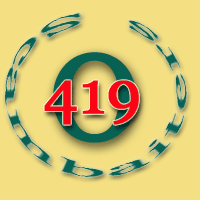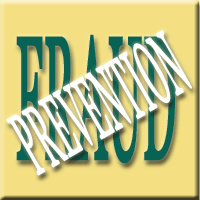
• Home •
Victim´s Story •
Fraud Prevention •
Project GSO •
Hall of Shame •
LINKS •

How to Detect Counterfeit US Money!
The most common Internet scams
The U.S. government estimates that less than 1/100 of 1 percent of U.S. paper currency in circulation is counterfeit. Considering recent advances in printing technology and the obviously vast incentive to counterfeit bills, that's a pretty small number. In part, that's because the U.S. Secret Service thoroughly investigates all reported counterfeiting cases, and because there are harsh criminal penalties for counterfeiting or passing fake bills. Perhaps more than anything, though, counterfeiting is difficult because of the bills' security features, which are hard to reproduce but easy to use to verify your money's authenticity.
Steps:
1. Feel the bill. Most people who handle money a lot (i.e. cashiers) can identify a lower-quality fake bill instantly just by touching it. You may not have that much experience, but just about everybody has handled enough money that they can detect many counterfeits simply by feeling them--and paying attention. Genuine currency has slightly raised ink that's produced in the intaglio printing process. You should be able to feel the texture of this ink, especially if you're handling a crisp, new bill.
The paper that money is printed on has changed little since the implementation of cotton rag. While money rag now has colored filaments, the traditional feel of money was intentionally left unchanged over the decades, because of its distinctive feel. The feel of a bill made fifty years ago should feel similar to a brand new bill.
2. Compare the bill with another of the same denomination and series. If the bill feels all right, or if you're a little suspicious but unsure, hold the bill side-by-side with another bill. Different denominations, obviously, look different, so get a note of the same amount. Also, all denominations except the $1 and $2 bills have been redesigned at least once since 1990, so it's best to compare the suspect bill to one in the same series (date).
3. The portrait on a genuine $50 bill (left) compared to a counterfeit. Notice the relative flatness and lack of detail on the fake bill.Look carefully at the printing quality. Real U.S. bills are printed using techniques that regular offset printing and digital printing (the most popular tools for all but the most sophisticated counterfeiters) cannot replicate. Look for blurry areas, especially in fine details such as around the borders--real bills have clear, unbroken borders--and on the Federal Reserve and Treasury seals, where the sawtooth points should be sharp and well-defined in genuine bills. Portraits in fake bills may appear dull, blurred, and flat, while in real currency the portraits are sharp and contain very fine detailing.
4. Look for colored strands in the paper.
All U.S. bills have tiny red and blue fibers embedded in the paper. Counterfeiters sometimes try to reproduce these by printing these strands onto the paper, but if you look closely, you'll see that they are printed on, rather than being part of the paper itself.
5. Hold it up to the light and look at the watermark. The watermark portrait should match the printed one (this is very important: bleaching & reprinting low value currency is a common scam).
6. Examine the serial numbers. Make sure the serial numbers on a bill match, and look at them carefully. Fake bills may have serial numbers that are not evenly spaced or that not perfectly aligned in a row. If you received more than one suspicious bill, see if the serial numbers are the same on both bills--that's a dead giveaway you've got a couple counterfeits.
7. $50 bill with three security features highlighted. A section of the security thread is visible in the circle near the portrait. The large circle to the right shows the watermark, and below that the color-shifting ink is circled.Look for special security features in all denominations except $1 and $2 bills. The easiest way to spot a fake $5, $10, $20, $50 or $100 bill is to look for the following security features, all of which are very difficult to convincingly fake.
8. Look for a security thread (a plastic strip) running from top to bottom. Beginning in 1990, an embedded (not printed) security thread was added to all bills except the $1 and $2 bills. If you hold the bill up to the light you easily see the strip and printing on it. The printing will say "USA" followed by the denomination of the bill, which is spelled out for $5, $10, and $20 bills but presented in numerals on the $50 and $100 bills. These threads are placed in different places on each denomination to prevent lower-denomination bills being bleached and reprinted as higher denominations. Compare a genuine bill of the same denomination to make sure the position of the thread is correct.
9. Hold the bill up to a light to check for a watermark. A watermark bearing the image of the person whose portrait is on the bill can be found on all $10, $20, $50, and $100 bills series 1996 and later, and on $5 bills series 1999 and later. The watermark is embedded in the paper to the right of the portrait, and it can be seen from both sides of the bill.
10. Tilt the bill to examine the color-shifting ink. Color-shifting ink (ink which appears to change color when the bill is tilted) was added to the $50 and $100 bills in 1996, the $20 bill in 1998, and the $10 in 1999; $5 and lower bills do not yet have this feature. The color originally appeared to change from black to green, but it goes from copper to green in recent redesigns of the bills.
11. Use a magnifying glass to examine microprinting. Beginning in 1990, very tiny printing was added to certain places (which have periodically been changed since then) on $5 and higher denomination bills. The exact location of the microprinting is not generally an issue. Rather, counterfeits will often have either no microprinting or very blurred microprinting. On a genuine bill, the microprinting will be crisp and clear.
12. The $5 bill has "USA FIVE" written on the thread, the $10 bill has "USA TEN" written on the thread; the $20 bill has "USA TWENTY" written on the security thread; the $50 bill has "USA 50" written on the thread; and the $100 bill has the words "USA 100" written on the security thread. Microprinting can be found around the portrait as well as on the security threads.
13. Hold the bill up to ultraviolet light. If authentic, the Security Strip in the bills will glow: $5 bill glows blue; the $10 bill glows orange, the $20 bill glows green, the $50 bill glows yellow, and the $100 bill glows red.
14. Run your finger nail over the "vest" of the bill, you should feel distinctive ridges, printers are not able to reproduce this ridge effect of a press.
Tips:
1. Look for differences, not similarities. Counterfeit bills, if they're any good at all, will be similar to real ones in many ways, but if a bill differs in just one way, it's probably fake.
2. An example of a EURion constellation on a U.S. $20 bill.Beginning with Series 2004, $10, $20, and $50 bills received a redesign with several changes to their overall look, notably the addition of more colors (see the picture of the $50 bill above).
3. Probably the most important new security feature is the addition of EURion Constellations, a distinct arrangement of symbols (in this case, numbers) which triggers many color photocopiers to refuse to copy the bill.
4. As the steps above explain, the $1 and $2 bills have fewer security features than other denominations. This is seldom a problem because counterfeiters rarely try to make these bills--it's a lot of work for a buck or two!
5. It's a common misconception that if the ink smears when you rub the bill on something, the bill isn't genuine. This isn't necessarily true, but ink that smears doesn't mean the bill is genuine, either.
6. The Secret Service and U.S. Treasury don't recommend relying solely on a "counterfeit-detection pen" of the kind you often see clerks use in stores. These pens can only indicate whether the a note is printed on the wrong kind of paper (they simply react to the presence of starch). As such, they'll catch some counterfeits, but they won't detect more sophisticated fakes and will give false-negatives on real money that's been through the wash.
7. "Raised bills" are a very simple type of counterfeit in which numerals are glued onto a low denomination bill to make it look like it's a higher denomination. You can easily spot these fakes by comparing the numbers in the corners to the denomination printed in letters at the bottom of the bill. If you're still not sure, compare the bill to another bill of the same denomination.
8. The ink used in U.S. currency is actually magnetic, but this is not a method for detecting counterfeits. The strength is extremely low and is useful only for automated currency counters. If you have a small but strong magnet (such as Neodymium) you can lift a genuine bill. Although you cannot lift the bill off of a table, you can certainly tell that it is magnetic.
Warnings:
1. This guide is intended only to aid in the detection of counterfeits. Counterfeiting is a federal crime punishable by jail time and fines.
2. Accurate counterfeits are nearly impossible to make and require more features than are described in this article.
3. Passing a known counterfeit bill is a federal offense. If you find yourself in possession of a fake bill or receive one from someone else, report it to your nearest Secret Service office. Do not relinquish or return the bill to anyone other than a Secret Service agent or law enforcement official, especially if you are a merchant. If you innocently receive fake money, law enforcement is often very understanding, but they will not reimburse your loss.
4. While many currencies from countries around the world use some of the same security features as are used on U.S. dollars, there are many differences, as well, and this article is only a guide to detecting counterfeit U.S. currency.
Reporting Fraud
In the event that you do detect fraud or have been a victim, please use the contact information below. Also, please forward a copy of the entire inquiry and/or correspondence with that individual to FindRentals.com so that we may block any further emails from that address.
• FTC toll free hotline: 877-FTC-HELP (877-382-4357 )
• FTC online complaint form (www.ftc.gov)
• Canadian PhoneBusters hotline: 888-495-8501
• Internet Fraud Complaint Center (www.ic3.gov)
• Internet Fraud Information (www.firstgov.gov/Citizen/Topics/Internet_Fraud.shtml)
• FBI (www.fbi.gov)
© by GSO • Contact